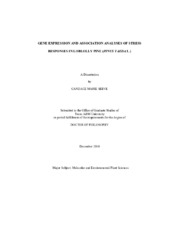| dc.contributor.advisor | Loopstra, Carol A. | |
| dc.creator | Seeve, Candace Marie | |
| dc.date.accessioned | 2012-02-14T22:18:47Z | |
| dc.date.accessioned | 2012-02-16T16:14:26Z | |
| dc.date.available | 2012-02-14T22:18:47Z | |
| dc.date.available | 2012-02-16T16:14:26Z | |
| dc.date.created | 2010-12 | |
| dc.date.issued | 2012-02-14 | |
| dc.date.submitted | December 2010 | |
| dc.identifier.uri | https://hdl.handle.net/1969.1/ETD-TAMU-2010-12-8890 | |
| dc.description.abstract | The molecular mechanisms underlying disease-resistance and drought-resistance in forest trees are not well understood. Linking variation in gene expression with genetic polymorphisms and with variations in disease- and drought-resistance phenotypes can provide information about these complex traits. We used real-time quantitative polymerase chain reaction (PCR) to detect variations in the expression of 88 disease- and drought-responsive genes within an association population of 354 loblolly pine trees (Pinus taeda L.). Using association genetics approaches, we then linked 3,938 single nucleotide polymorphisms (SNPs) in candidate genes with gene expression phenotypes to identify novel disease- and drought-responsive genes. To further examine differences in gene expression induced by drought, Fusarium circinatum (responsible for pitch canker disease), and drought F. circinatum, the expression of 114 genes identified through comparative and association genetics approaches was analyzed on a subset of 24 loblolly pine trees possessing a range of pitch canker- and drought-resistance phenotypes.
Significant differences in the uninduced expression of all 88 genes measured on the association population were observed among loblolly pine trees. Principal component analysis showed that some variation within the association population could be accounted for by population substructure of geographic origin. Hierarchical clustering of genes based on uninduced expression did not consistently group together functionally similar genes probably because expression was collected on unstressed stem tissue. This was supported in the smaller expression study as correlations between expression values of genes in the same functional networks were usually stronger when induced by a treatment compared with correlations between the uninduced expression of genes in the control group. Gene expression frequently changed by up to 4-fold in response to one or more treatments, but PtMYB12 was the only gene that exhibited a statistically significant change in response to treatments. ANOVA analyses of gene expression controlling for pitch canker resistance and for water use efficiency phenotypes identified differentially expressed genes suggesting that they may be contributing to these phenotypes. Finally, association genetics approaches detected 101 significant associations between SNPs in 94 candidate genes potentially involved in stress responses and 27 gene expression phenotypes. | en |
| dc.format.mimetype | application/pdf | |
| dc.language.iso | en_US | |
| dc.subject | loblolly pine | en |
| dc.subject | Pinus taeda | en |
| dc.subject | disease | en |
| dc.subject | drought | en |
| dc.subject | pitch canker | en |
| dc.subject | gene expression | en |
| dc.subject | association genetics | en |
| dc.title | Gene Expression and Association Analyses of Stress Responses in Loblolly Pine (Pinus taeda L.) | en |
| dc.type | Thesis | en |
| thesis.degree.department | Ecosystem Science and Management | en |
| thesis.degree.discipline | Molecular and Environmental Plant Sciences | en |
| thesis.degree.grantor | Texas A&M University | en |
| thesis.degree.name | Doctor of Philosophy | en |
| thesis.degree.level | Doctoral | en |
| dc.contributor.committeeMember | Krutovsky, Konstantin V. | |
| dc.contributor.committeeMember | Appel, David N. | |
| dc.contributor.committeeMember | Hays, Dirk B. | |
| dc.type.genre | thesis | en |
| dc.type.material | text | en |


